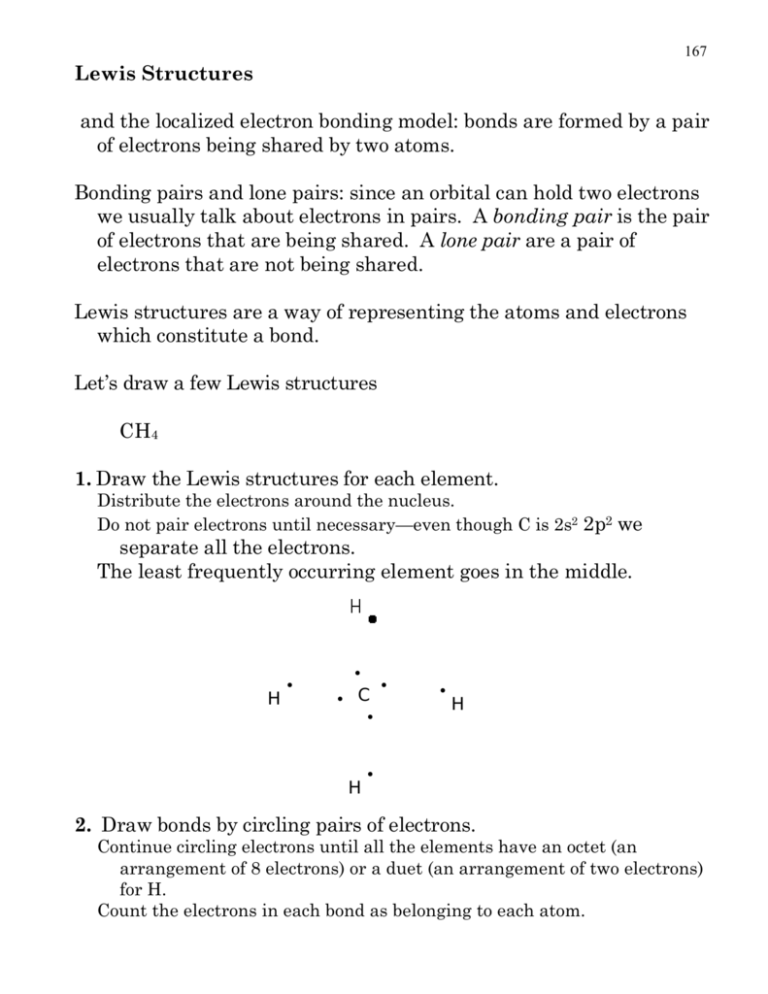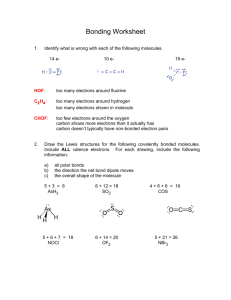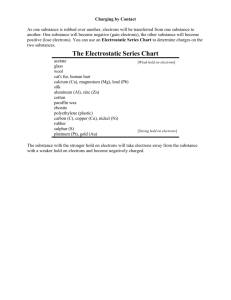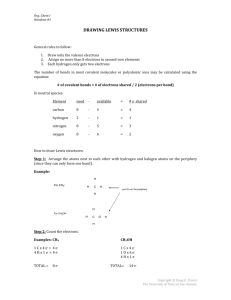p167-178 Lewis Structures
advertisement

167 Lewis Structures and the localized electron bonding model: bonds are formed by a pair of electrons being shared by two atoms. Bonding pairs and lone pairs: since an orbital can hold two electrons we usually talk about electrons in pairs. A bonding pair is the pair of electrons that are being shared. A lone pair are a pair of electrons that are not being shared. Lewis structures are a way of representing the atoms and electrons which constitute a bond. Let’s draw a few Lewis structures CH4 1. Draw the Lewis structures for each element. Distribute the electrons around the nucleus. Do not pair electrons until necessary—even though C is 2s2 2p2 we separate all the electrons. The least frequently occurring element goes in the middle. H • • • C • H • • H • 2. Draw bonds by circling pairs of electrons. Continue circling electrons until all the elements have an octet (an arrangement of 8 electrons) or a duet (an arrangement of two electrons) for H. Count the electrons in each bond as belonging to each atom. 168 H • • • C • H • • H • So, here we have C with 8 electrons, and 4 H’s with 2 electrons. 3. Redraw the structure replacing circled pairs of electrons with lines indicating bonds, and distribute unshared pairs of electrons evenly around the atom to which they belong. no unshared pairs in CH4 so no need to worry about this H H C H H 4. Calculate the formal charge of each element. Formal Charge = # e-’s element started with - # e-’s element ended up with Carbon started with 4 e–’s. Now how many did it end up with. # e-’s element ended up with = # unshared e -’s + 1 /2 # bonding electrons So for C, F.C.= 4 - (0 + 1/2 8) = 0 H, F.C.= 1 - (0+ 1/2 2) = 0 Write formal charge next to element (0 charge is omitted). 169 Do NH3 1. H •• • • N • H • • H • 2. H •• • • N • H • • H • 3. •• N H H H 4. H = 1 - (0 + 1/2 2) = 0 N = 5 - (2 + 1/2 6) = 0 Do CO2 1. •• • • • O • • • C • • • • • O • •• 170 2. •• • • • O • • • C • • • • O • •• • not enough electrons 6 around C, 8 around one O. Keep circling. •• • • • O • • • C • • • • O • •• • 3. • C O • • • • • • • O 4. C = 4 - (0 + 1/2 8) = 0 O = 6 - (4 + 1/2 4) = 0 Do H3NO 1. •• • • • O • H • •• • N • H • • • H 171 2. •• • • • O • H • •• • N • H • • H • N is in an octet but O is not, and there are no more unpaired electrons, what is one to do? Learn to deal with adversity and improvise. O is going to attract two more electrons from the N...like this... H • •• •• • • O •• • N • H • • • 3. H N H •• •• • • O H H 172 4. N = 5 - (0 + 1/2 8) = 1 O = 6 - (6 + 1/2 2) = -1 •• •• • • O + H N H H Although H 3NO might not exist a very similar compound does exist (CH3)3NO. (CH3)3NO is very good at adding one O atom to other compounds. (Can you draw (CH3)3NO?) What is the difference between H3NO and H2NOH? •• •• H H vs N O H •• N •• H O •• •• H H Draw a Lewis structure for NO3– (nitrate) remember there is one extra e– (that is why there is a negative charge). Ah...but where does that extra electron go? Give the extra electron to the most electronegative element. 1. extra e •• • • • O • •• • N • • • •• • • • O 2. •• • • O • •• 173 •• • • • O • •• • N •• • • O • •• • • • •• • • O • d’oh! all out of unpaired electrons! Deal with adversity and move on... • • O •• •• • N • • •• • • O •• •• • • O • •• •• • N • • •• • • O • • •• •• • • O • • 3. • • • • • • O • • • • O • O = 6 - (6 + 1/2 2) = -1 O = 6 - (4 + 1/2 4) = 0 - • • • • • • • • • • • • N O + • • • O O • two O’s one O • N 4. N = 5 - (0 + 1/2 8) = 1 • • • • O •• • • O • •• 174 4b. indicate total charge with brackets - • • • • • O • • O • N • O • • • + • • - • • This structure brings up an interesting point. • O • • N • O O • •• • • - •• + O •• • • - •• + • • • N O • • • • O - • • • • • • - •• - 5. This is called resonance and it occurs when there is more than one valid Lewis structure for a given molecule. It is important to note that no atoms move when a resonance structure is drawn. If an atom moves then what has been drawn is not a resonance structure. There is one more valid structure for nitrate... • N + •• •• - O • • • O •• •• •• • • - 175 •• • • δ- O N δ- - O •• •• Since all these resonance structures are equal in energy the actual molecule is an average of the three, and the structure can be represented as... + • • • • δ- Dashed bonds are used to indicate partial bonds; however, because a popular chemical structure drawing program cannot draw dashed bonds often times curved solid lines will be used instead like in acetate... O H 3C - C O Do SO42- (sulfate) 1. •• • • • O • •• • S • • • •• • • O • •• • • • •• • • O •• • • • O • extra e - extra e - 176 2. •• • • • O • •• • S • • • •• •• •• • S • • • • • O •• • • O • •• • • • •• • • O • • • cope move on 3. •• • • • O • •• •• • • O •• S •• •• • • O • • O’s O = 6 - (6 + 1/2 2) = -1 •• • • • O • •• • • O •• S • • 2+ - •• • • O 4. S = 6 - (0 + 1/2 8) = 2 • O • 2- •• • O • •• •• • • O •• • • • O • •• • • • O • • •• • O • •• 177 5. Normally one would say that no resonance structures can be drawn, but 3rd period elements are special. Remember 3rd period elements have d orbitals they are just not filled. There is so much attraction by the S2+ that it attracts the electrons of the O-. • • O •• S •• • O • •• S - • • •• • • - 2- O S O - • • • • •• •• •• - O • • O 2- •• •• ••O •• • • O • • 2+ 2- •• •• - •• • • • O • •• • • O •• • • • O • •• •• O Now you say there are too many electrons around the sulfur...that is OK. The 3rd period elements can expand their octet by using the 3d orbitals. Also notice that the two structures on the left look similar, so the average structure looks more like the two on the left than the one on the right. 178 Some simple rules... For us H will ALWAYS have only one bond (it is possible to have more, but we will not discuss anything like that; furthermore, you will not discuss it unless you take a class in Advanced Inorganic Chemistry.) First row elements will have a maximum of four bonds. Carbon will always have four bonds (once again 5 is actually possible...go to graduate school and find out how, 3 bonds are possible for a reaction intermediate.) Oxygen will usually have two bonds. O can have 3, but will have positive charge Nitrogen will usually have 3 bonds. N can have 4, but it will have a positive charge. Halogens will usually have 1 bond, but can have more when they are part of a polyatomic ion. Tips… • • OK O • • • • Draw the electrons like they are near the corners of a box, not in the middle of a side (don’t draw the box). • • • O • • • not OK •• O • •• •• When you draw the atoms on the page try to draw unpaired electrons pointing towards each other. • • • H O •• • H • not • • H H Circling electrons and drawing bonds will be easier this way. Finish off the easiest elements first. If an element has 7 electrons find an unpaired electron an make a bond, then you do not have to worry about that atom any more. Completely finish an element’s valence shell before moving on to the next element.





